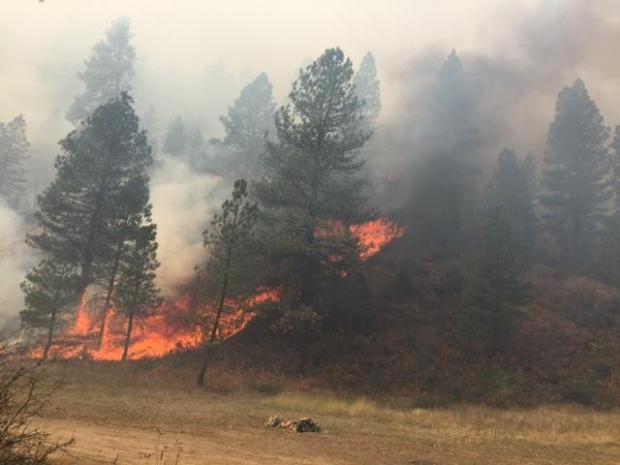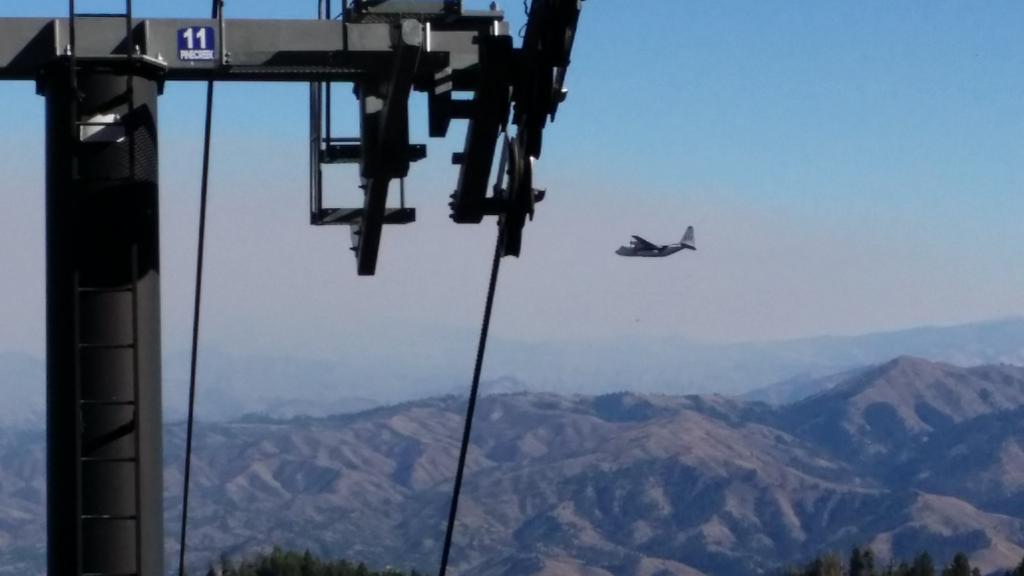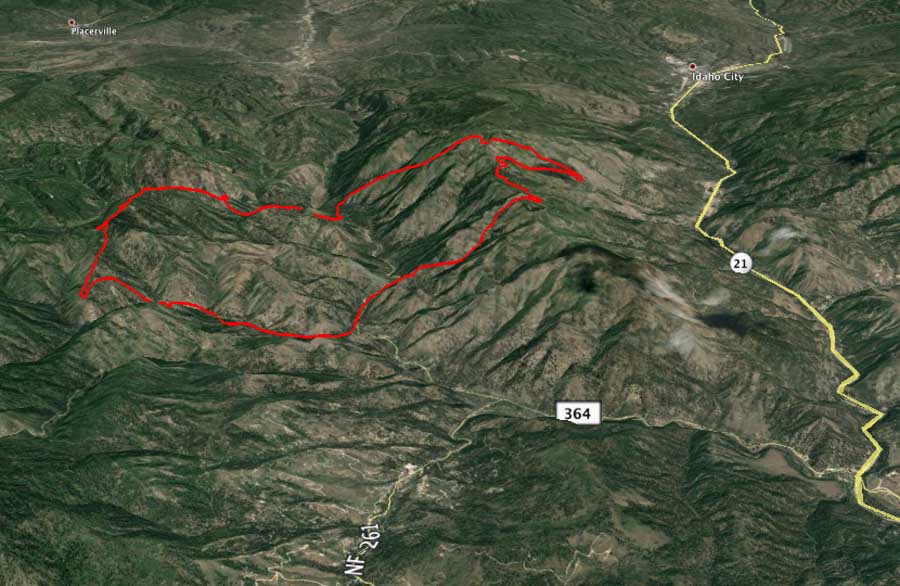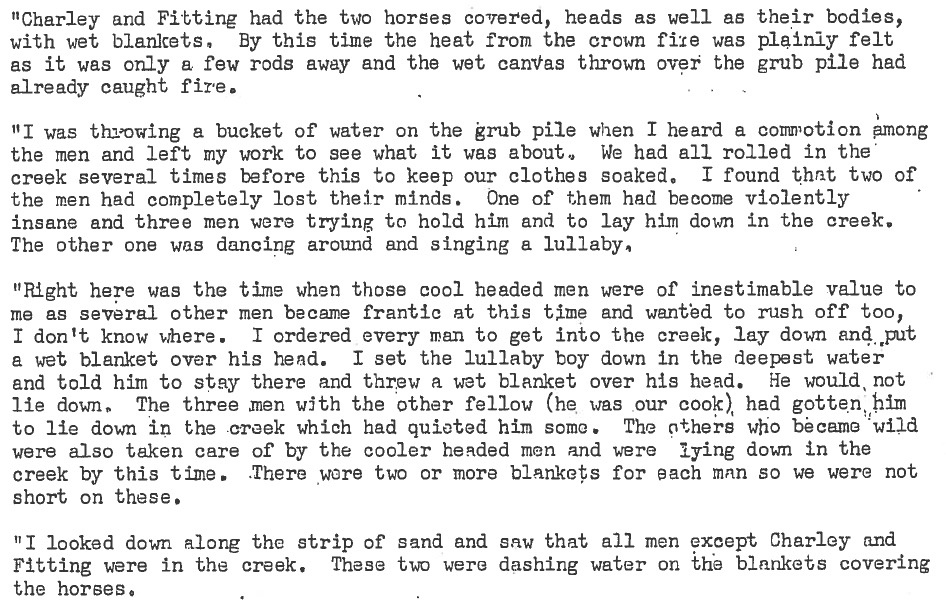Tag: Idaho
1942 typewritten account of the 1910 Big Burn Fires uncovered
Britt Rosso of the Wildland Fire Lessons Learned Center discovered a 23-page typewritten account of some of the stories from the 1910 Big Burn fires that blackened huge areas of Idaho and Montana — the fires that changed the course of fire management in the United States.
Mr. Rosso describes his find:
As I was digging through some boxes at work, I came across a hard copy of this report on the 1910 fires. It was written in 1942 by Elers Koch, who was the Forest Supervisor on the Lolo NF in 1910. He created this 1910 fire summary so history would not be forgotten. It’s now posted on our LLC web site.
There are some amazing stories in here, and there are also reports from seven different fire crews on how they dealt with the “Great Fire”. There is a crew story in here about “burning off a large area…thinking that they would have absolute protection”. Maybe Wag Dodge wasn’t the first FF to ever use an escape fire.
Take your time and read it slowly.
Since documents at the Lessons Learned Center are known to be moved around and become difficult to find, we stashed a copy here for our readers.
One of the stories features the 30-person Moose Creek Crew led by Deputy Supervisor Ed Thenon, who wrote the account. (It is not clear what Forest Mr. Thenon was from.) They were working on a fire in Idaho in the upper Selway River area near Moose Creek. The sleeping crew, which was in an unburned area not near the fire edge, was aroused at 10 p.m. by debris falling in their area. Soon what one of the men thought was a “falling star” landed nearby and started a spot fire. When they could see the fire approaching they moved their camp and their food, or “grub”, to a small six-foot wide sand bar, or strip, in a creek that had water six to eight inches deep. Mr. Thenon told the men to lie in the creek and put wet blankets over their heads. Wet blankets were also put on their horses.
Below is a brief excerpt from his account. Click on it to see a larger version:
Even though two men ran off and took refuge in another area, all 30 of them survived. However “the ‘lullaby boy’ was taken to an asylum”.
Thanks and a tip of the hat go out to Mike.
Incident Commander reportedly removed from team after incidents with landowners

On several occasions while talking to firefighters, the landowners had been very insistent that certain more aggressive tactics should be implemented. Our first article on this issue provoked a lengthy response from a person believed to be one of the landowners, or at least a person very familiar with the details who sympathized with them.
Rocky Barker, a writer for the Idaho Statesman, reported today that IC Chris Ourada, the fire management officer on the Caribou-Targhee National Forest in southeast Idaho, was taken off the Great Basin Type 1 Incident Management team that was assigned to the Tepee Springs Fire east of Riggins, Idaho from August 28 until September 12, 2015.
The latest roster for Great Basin Team 2 updated on October 7, 2015 lists Paul Broyles, who retired in 2008, as the IC. When we viewed the roster on September 27 Chris Ourada was the IC and Mr. Broyles was the Deputy IC. That earlier roster, dated February 2, 2015, has been deleted but can still be viewed on the Way Back Machine. Interestingly, the file name for the current roster is “Ourada_Master.pdf”.
It is very unusual for an Incident Commander to be replaced late in the fire season — on October 7 in this case. More commonly, major changes to a team are made in the winter.
The two SAFENET reports state that hotshot crews had not been constructing direct fireline on the edge of the fire near the private land due to numerous conditions that made that particular tactic unsafe, including cliffs in the area, the location made it impossible to extract resources if an injury occurred, no safety zones were available if fire behavior increased again, and the presence of a nearby under-slung mid-slope fireline.
Two hotshot crews refused to take on the risk of the direct fireline assignment. After explaining their rationale to the IC and the safety issues involved, the firefighters were reportedly told by the IC:
I’m the Incident Commander and you will do what you’re [expletive] told.
The official public response to the two SAFENET reports, issued October 5, 2015, said a “…team chartered by the Great Basin Coordinating Group [conducted] a review … and identified specific improvements and corrective actions, which are currently being implemented”.
Jennifer Jones, a national spokesperson about fire issues for the U.S. Forest Service in Boise, would not comment on the reported removal of an incident commander, except to refer us to a statement from the Regional Fire Director for the Intermountain Region, Sue Stewart:
Safety is always the top priority for the U.S. Forest Service. Professional firefighters review all reports in SAFENET and ensure that appropriate actions are taken to correct any behaviors, systems or communication issues that could put fire fighters at risk. The Tepee Springs incident was thoroughly reviewed and appropriate actions were taken.
E. Wade Muehlhof, a spokesperson for the Intermountain Region which includes the area where the fire occurred, told us:
The decisions or recommendation made by the review panel are treated like personnel issues and are private.
In 1999 due to many mistakes, errors in judgement, and shear laziness by incident management team members on the Sadler Fire near Elko, Nevada that resulted in several firefighters being overrun by the fire, not only was the IC removed, but the entire team was disbanded. In addition, five members of the Command and General Staff had the fire qualification for their position on the team suspended until they could be recertified. The positions involved included the Incident Commander, the Planning Section Chief, the Safety Officer, and two Operations Section Chiefs.
More information on Wildfire Today:
—Our original article about the issues with the landowners and the incident commander.
—A further look into the landowner/firefighter disagreement in Idaho
Thanks and a tip of the hat go out to Chris.
Walker Fire, near Idaho City, ID

The Walker Fire has burned about 4,200 acres since it started on October 10, 5 miles southwest of Idaho City, 5 miles east of the Bogus Basin Mountain Recreation Area, and 14 miles northeast of Boise.
It is difficult to find much information about it since the National Interagency Fire Center no longer updates the national situation report daily and the Great Basin Coordination Center’s web site reports “No Large Fires in GBCC”.
Strong winds on the day it started spread it across 2,500 acres by the next morning on lands managed by the Idaho Department of Lands, Southwest Forest Protective District, and the Boise National Forest. It is burning on both sides of Grimes Creek Road. Three cabins and one outbuilding have been destroyed.
The fire was very active on the north side on Tuesday.
Evacuations have been ordered for residents in Macks Creek, Wolf Creek, and Pine Creek.
Smoke from the fire has caused air quality alerts in the Treasure Valley area.


A further look into the landowner/firefighter disagreement in Idaho

The disagreement between an Idaho landowner and firefighters is drawing more attention. Rocky Barker, a reporter for the Idaho Statesman with a long history of writing about wildland fire, posted an article on the newspaper’s website today.
As we wrote on September 27, the owners of private property affected by the Tepee Springs Fire east of Riggins, Idaho were not pleased with the tactics and strategy being employed on the fire or their interactions with the Incident Management Team fighting the fire.
But some of the firefighters felt threatened by the land owners. According to a report filed on SAFENET, “Two of the land owners verbally accosted a BLM employee while armed with a weapon.”
The unidentified author of the SAFENET report also wrote, “…the land owners took it upon themselves to attempt a burnout and began igniting fire below crews without any communication or warning. Crews had to be pulled to safe areas….The land owners made multiple unsafe demands to fire fighters such as downhill line construction in extremely rugged terrain with fire below them, attempting burnouts on mid-slope dozer lines with no escape routes or safety zones, and to drop water from helicopters with personnel in the work zone (the land owners).”
Law enforcement officers had to be called more than once and two hot shot crews refused an assignment ordered by the incident commander due to what they thought were unsafe conditions caused by the actions of the landowners.
In Mr. Barker’s article he writes that the author of the very lengthy comment on our September 27 article left by “Landowner” was in fact Brad and Sarah Walters, the son and daughter-in-law of the owners of the Mountain View Elk Ranch on the West Fork of Lake Creek, three miles east of Riggins.
On their 1,200 acres the landowners raise elk which they allow their clients to shoot, charging $5,900 to $14,000 per animal depending on the size of the rack. Shooting a buffalo costs from $4,000 to $7,500. This kind of canned hunting of domestic animals is outlawed in Wyoming and Montana according to a 2006 article at KOMO news that featured the Walters’ ranch.
The video below is basically an audio recording of a phone conversation. It was posted on September 7 by Sarah Walters, and is described as a “conversation with Mark Giacoletto IC of the Tepee Springs Fire on 9-7-2014 at 1:30.”

Our take on the situation
All of the facts have not yet been ferreted out, but after reading what is available about this incident, here is how it appears to us. Admittedly, this is from the view of someone who was a full time wildland firefighter for 33 years, but is trying to understand both sides of what could be categorized, at this stage, as a he-said, she-said situation.
The Walters obviously wanted to protect their property which generates income from people being charged to shoot the elk they raise on their property. They probably felt that if any of the land burned it would diminish the esthetic appeal, appearance, grazing, the number of shooters they hosted, and water quality. By insisting on aggressive fire suppression tactics they may have thought that if there were any safety concerns by employing those tactics, that it was worth the risk to the firefighters. They apparently thought that there was a strong possibility that the fire would continue to spread significantly and burn their property.
The firefighters may have analyzed the fire conditions, the weather forecast, and the predicted fire behavior and decided that with the weather and the time of the year, there was little chance that the fire in that area would burn additional acres on the property. They may have also been concerned about the safety of the firefighters on the ground and in the air if they had to be committed to additional aggressive suppression activities in the rugged terrain. Mr. Barker reported that Sarah Walters was a firefighter for five years, but her expertise about fire behavior and appropriate firefighting tactics would pale in comparison to the knowledge, training, and experience available within the Type 1 Incident Management Team assigned to the fire.
Report of trouble with landowners on the Tepee Springs Fire in Idaho
(UPDATE, October 1, 2015: we further analyzed this incident in a new article, including additional information.)
According to a report filed on SAFENET, a private landowner in Idaho armed with a weapon aggressively accosted firefighters and interfered with fire suppression operations in several other ways. Law enforcement officers had to be called more than once and two hot shot crews refused an assignment ordered by the incident commander.
This occurred on the Tepee Springs Fire which is three miles east of Riggins, Idaho on the Payette National Forest. As of September 24, 2015 the fire has burned over 95,000 acres.
The “event start date” in the report was September 2, 2015 but the harassment apparently occurred over multiple days.
Records show that the Great Basin Incident Management Team #2, led by Incident Commander Chris Ourada, was assigned to the fire from August 28 until September 12, 2015.
It is not clear what person or position on the fire filed the report. This may be just one side of the story, but we will be interested to see if the charges in the report hold up, and what corrective actions will be taken, if there is a need for any, other than “[we are] looking in to this matter”, and “thank you”.
Below is the Narrative from the report. Following that is the “Immediate Action Taken”, and the “Corrective Actions”.
****
Narrative:
On Division Delta on the Tepee Springs fire a “turn down” of assignment occurred where two IHC’s refused an assignment due to numerous safety concerns that were not mitigated. These safety concerns will be addressed below. The IC of the incident responded to this turn down by stating “I am the boss, you work for me and you will do what I say. And I am saying go in there and go direct!” In response to this the crews still refused the assignment and were sent to another division the following day and remained on those divisions for the remainder of the assignment.
Division Delta on the Tepee Springs fire featured large tracts of private land mixed with State, Forest Service, and BLM land. A large elk ranch lay in the middle of the division and was the epicenter of the issues. The land owners, on multiple occasions expressed frustration towards fire fighters with their suppression actions which ranged from verbal threats to aggressive posturing. LEO’s were called on multiple occasions and the incident eventually resulted in two of the land owners verbally accosting a BLM employee while armed with a weapon. The land owners made multiple unsafe demands to fire fighters such as downhill line construction in extremely rugged terrain with fire below them, attempting burnouts on mid-slope dozer lines with no escape routes or safety zones, and to drop water from helicopters with personnel in the work zone (the land owners).
During at least one documented occasion the land owners took it upon themselves to attempt a burnout and began igniting fire below crews without any communication or warning. Crews had to be pulled to safe areas during this. Other unsafe suppression actions by the land owners were extremely fast driving, attacking fires at the head, felling trees in the middle of crews, and operating dozers on federal and state land with no communication with fire resources. In addition to the ill-advised suppression actions their continued harassment of fire line personnel in an attempt to force their own initiatives distracted important leaders from their primary jobs of managing people as well as the entire division and the fire as a whole.
Continue reading “Report of trouble with landowners on the Tepee Springs Fire in Idaho”


